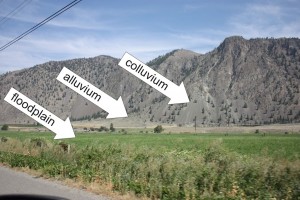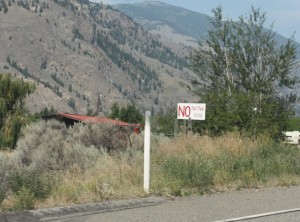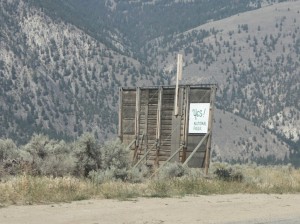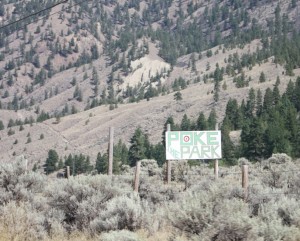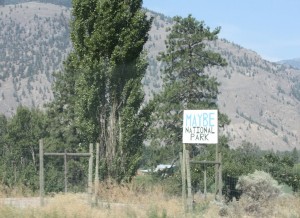One of the spectacular stretches for a geologist is west of Richter Pass, as you drop into the wide, flat Similkameen Valley, bounded by the vertical wall of the Catherdal Range of the Okanagan Mountains. The valley floor has a classic underfit meandering river flanked by the shallow drapes of alluvial fans leading up to much steeper scree slopes of colluvium. Traditional ranching and hay fields on the slopes are increasingly being turned over to viniculture, while the orchards of Keremeos continue to pound out unreasonably good cherries, apples, and stone fruit.
Aside from the human uses, these grasslands represent a rare ecosystem in British Columbia: A sagebrush desert. With rapid development up the mountains in the adjacent Okanagan Valley, these ecosystems are under a lot of pressure. To call it a desert makes it sound, well, deserted, but this area has the highest concentration of threatened or endangered species of any similar-sized region in Canada; at least 23 different listed species, from Pacific rattlesnakes to Flammulated owls, and one-third of the red-listed species in the Province. Protection is spotty, development is encroaching, and the ecosystem is threatened.
With this in mind, the (Liberal) Federal Government signed a memorandum of understanding with the (Liberal) Provincial Government in 2003, to do the appropriate feasibility studies towards developing a National Park or National Reserve Lands (the first in the Okanagan). The MOU includes the statement:
“On February 11, 2003, the Government of British Columbia announced in its Speech from the Throne its interest in exploring the potential for establishing a new National Park Reserve in the Okanagan area, and its “Heartlands Economic Strategy” by which economic development plans will open up new opportunities for tourism, resort development and recreation, among other things, in the Province of British Columbia”
People who like to shoot things and burn hydrocarbons for entertainment. That’s who.
A local “No National Park” movement began, led by a small but determined group of hunters and ATV enthusiasts out of Oliver, BC, who were offended that their chosen recreation activities may be even slightly encroached upon in the name of protecting ecological lands or endangered species.
Long story short, after 9 years of consultation, the Province caved. With her characteristic ability to solve problems, bring people together, and provide leadership you can believe in, our Premier was unable to voice support for a Park that had broad local and First Nations support, with backing from a broad range of people and groups across the country. Apparently recreational lead-shooters and gasoline-burners have a lot of voice in one of the last remaining BCLiberal strongholds in the Province. The Federal Conservative Government, citing a lack of interest on the part of the BC Liberals announced this spring that they would no longer explore the Park. Even while they announce a big park up North that will apparently feature spectacular mining expanses.
The fight may be over (or not…), but the signs are still up all through the Similkameen Valley. To me, this entire story has been about a 9-year sign war played out across the Cawston countryside. That small, organized group did a good job plastering Highway 3 with red-on-white signs, stating “No National Park”, confusing the hell out of thousands of RVs from Alberta and Germans in rental cars every year. Really, it does not present the most inviting message to passing drivers: “Wer ist gegen einen Nationalpark?!?”
And even some more creative approaches:
And now, with the entire thing in limbo, maybe the time was right for the ultimate modern slacktivist movement:
Now there is a protest I can believe in.
